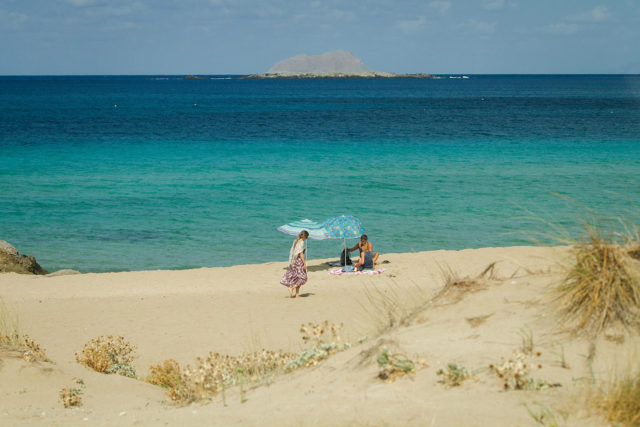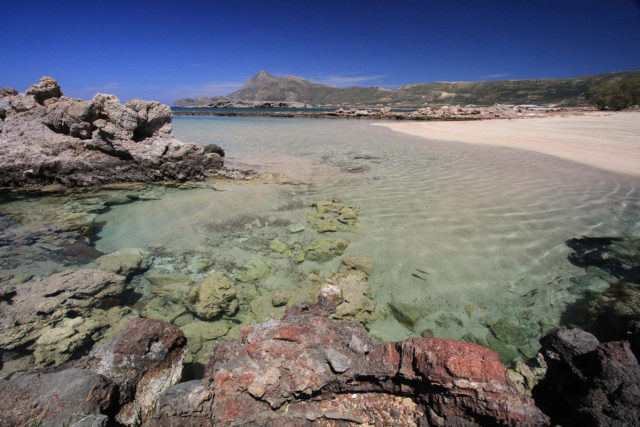Falassarna beach
THE MOST
POPULAR BEACH
Falasarna beach is located on the Gramvousa Peninsula, 15 km west of Kissamos. This is one of Greece’s most renowned beaches, listed in the top ten of dreamy European shores and has been awarded in the past as Crete’s finest beach. With a vast, ca. 3 km, coastline that essentially consists of five consecutive beaches divided by rocks or sand dunes, with two of them attracting the largest crowds. The most popular is Pachia Ammos, spanning 1 km in length and of ample width; that is why it never looks crowded no matter how many its visitors. Its waters reflect a transparent turquoise tint, thanks to its thin, light-coloured sand and is fully organised hosting restaurants, cafés and bars, water sports services, umbrellas, a beach volley court and ample room for those bringing their own umbrellas. North of Pachia Ammos lies the second largest beach, 800 m long, which splits into smaller strands by rocks and a sand dune. Although without further infrastructure it is very tranquil and its visitors can get drinking water from a spring at a nearby chapel, dedicated to Agia Paraskevi. At its northernmost edge, close to the archaeological site of Falasarna, a small inlet is ‘hidden away’, protected by the strong west winds that sweep the area, facing south, with a pebbly beach and rocky seabed, making it an ideal alternative to those seeking privacy. South of Pachia Ammos, at Livadi, a sandy beach of stoney seabed stretches out; an excellent choice to explore the underwater world snorkelling. Even further south, next to a small harbour, lies a petite pebbly beach of absolute serenity. More than often, northwest winds blow in the area, raising big waves, something that makes the place a windsurfer favourite. Falasarna beach is equally famous for its majestic sunset, which is considered the best in all Crete because of its unhindered horizon view, as visitors literally watch the sun dive in the sea. It is listed in the ‘Natura 2000’ European protection network as a natural setting of unique beauty and rare flora and fauna. Lately and in particular since 1995, every first Saturday in August sees a beach party being thrown with crowds pouring in to camp on the beach and party all night under the sounds of various DJ’s.
HIGHLIGHTS
- Blue flag
- Free parking
- Water Sports
- Traditional restaurants
- The sunset
- The view on your way down to Falassarna
It has crystal clear waters and wonderful white and pink sand. When the wind picks up and sea waves begin to come in one after the other, this is the best time for windsurfing lovers to arrive. Indeed an absolute adrenalin rush, not only for those who take part in the sport but also for those who delight in watching windsurfers “play” with the waves created by nature.
The beach of Falassarna extends over a very large area (about 3 kilometres from one end to the other). For practical purposes the locals have given names to different parts of the beach, for example, “Bourouni”, “Kalami”, “Agia Paraskevi” e.t.c. The most famous part of the beach Falassarna is called Pachia Ammos (Bourouni, Avoratias & Gulisma) it’s an exotic wide sandy beach about 1 kilometre long.
All the beaches we have mentioned so far are organised and you can find there all the modern comforts. You can have a wonderful time either lying under the sun or doing any water sport you wish for. The beaches meet all standards and justly, there are 2 Blue Flags (Pachia Ammos).
Falassarna is ideal for those wishing to spend their holiday in a quiet place with beautiful beaches and the option for many excursions. It is also an idyllic place for couples in love, as here you will enjoy the most beautiful sunset in Crete.
Falassarna is neighbouring with the village of Platanos. It is a big, pretty village, one of the biggest of the Prefecture of Chania. It belongs to the Municipality of Kissamos and it is only 40 min. (by car) from the city of Chania. Built at an altitude of 240m, it is the ideal spot for combining beach and mountain, as it is a mere 5Km from pretty Falassarna.
It got its name from the sycamore tree, very old now, in the centre of the small picturesque square of the village. It has been standing there for centuries, since the time of the Turks.
As the limerick goes…
My Mediterranean sycamore, how proudly you’re standing…
You can find all the information you need about Platanos and the Falassarna region in the tourist guide prepared with such enthusiasm by the association of the locals:
www.visitfalassarna.com
DISCOVER ALSO
Balos Lagoon
Balos lagoon is a heaven on earth of turquoise waters, pink-tinged white sands and wild, exotic beauty. Located at 17 km northwest of Kissamos, between the Gramvousa Cape and small rocky peninsula of Tigani, which connects with the rest of Crete via a thin strip of land, thus forming the famous Balos lagoon. Its southwest side is open to sea and forms a natural harbour, protected by winds due to the islet of Imeri Gramvousa across from it. On its open side the shore is deeper and rockier at places; a favourite for spearfishermen and scuba divers. The other side of the lagoon is closed to the sea and forms a generally quite shallow lagoon, except for some deeper places…
Elafonisi beach
It takes a few seconds for the visitor arriving at Elafonisi to grasp the majestic, natural masterpiece that is laid out before them. A small peninsula split at its tip by the sea’s waters, resembling a separate island. The setting is tropical and enchanting, triggering an instant sense of marvel. Thin, white and pink tinted sands, cedars, jade crystal-clear waters, a natural lagoon at its north side, the open sea at its south, all underlined by the endless horizon. The beach prompts to an exotic paradise similar to the Caribbean, though perhaps of more beauty because of its iridescent shore; scores of minuscule crustaceans, called Foraminifera shed their shells on the beach, as they die, which are crushed to smithereens…




